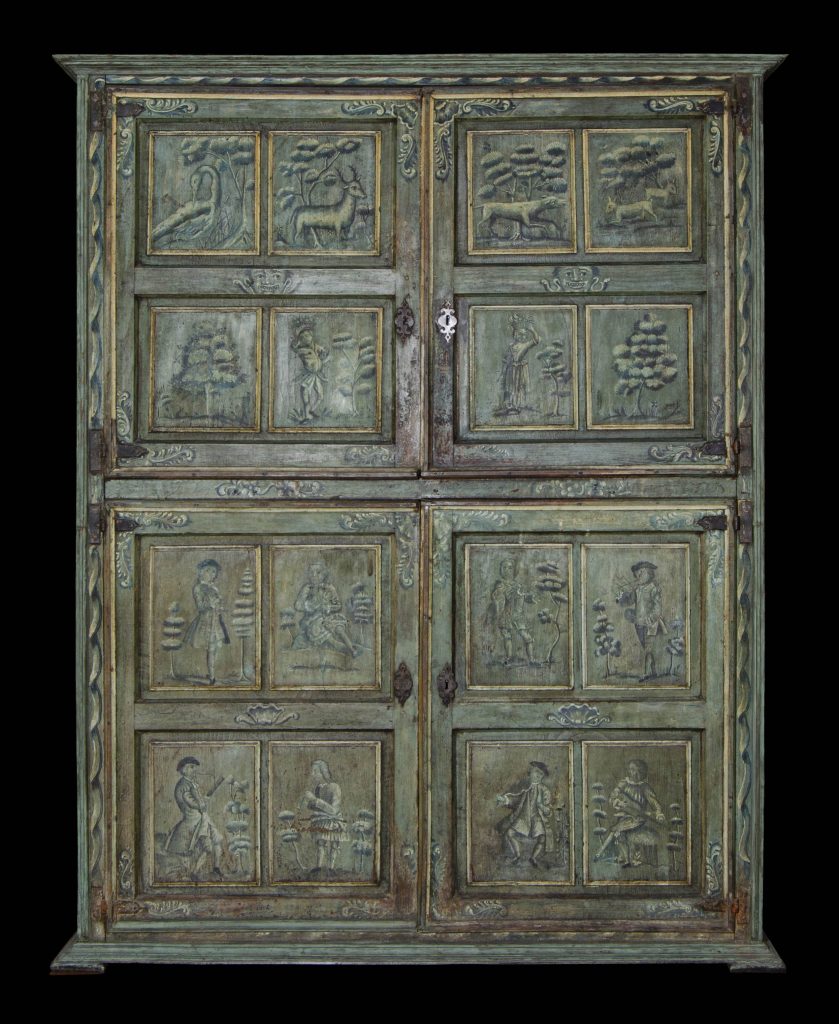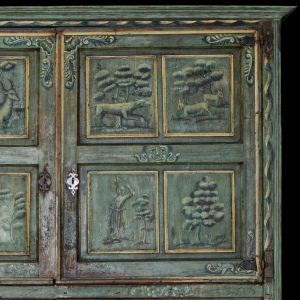Armoire
Author: Unknown
Origin: Unknown
Dating: 17th century
Material: Wood (Chestnut) & metal
Dimensions (cm): 225 x 172,5 x 83
Inv. no.: PD0066
«An Armoire is “a piece of furniture for storage, usually high, consisting of one or more closed units, accessible by doors or by sliding or extending panels. […] Its interior is composed of elements for hanging, shelves and/or drawers. It sits on a movable or on a fixed base […]”. Within its characteristics, this piece of furniture may be classified as a cupboard that Sousa characterizes as follows: “a piece of furniture generally consisting of two bodies, the upper one being higher, used to store and display tableware. […] Its interior usually has shelves or partitions specifically designed to hold the pieces” (SOUSA, 2004: 91 e 92).
[…]
The Armoire consists of two units – a lower and an upper one – each with eight decorated panels. The eight upper panels feature vegetal motifs, animals and two figures – one male and one female – both carrying baskets on their heads, which may symbolize abundance.
The panels of the lower register are decorated with eight musicians, each playing a different instrument: violin, clarinet, bassoon, oboe, transverse flute, tambourine and flute, vielle and guitar.»
Eduardo Magalhães
“Music in the Palace’s Collections”
«The Violin is represented on the first panel of the lower body of the armoire […] The figure – dressed in a coat, overcoat, breeches and with a hat on his head – is standing outdoors and playing the instrument.
[…]
The instrument, which is quite stylized, does not allow one to see any details that would help to characterize it better. It appears to be smaller than it would normally be, considering the proportions of the musician.
[…]
The clarinet is represented on the second panel […]. The musician is sitting with his legs slightly crossed, among vegetal motifs, playing the instrument. He is dressed in the fashion of the 16th and 17th centuries: overcoat, coat and breeches, although they are not very noticeable. By its apparent size – since the image does not allow for a detailed observation – the instrument is of the type used initially in orchestras […]. They were instruments of approximately 50 to 60 cm […]. Due to the absence […] of the bell at the end, this clarinet resembles the oldest surviving specimen, that of Gottlieb Crone.
[…]
The transverse flute is represented on the third panel […]. The flautist of the armoire is presented, like all the other figures, elegantly dressed – in an overcoat, coat, and breeches, with his head uncovered. […] He plays outdoors, considering the shrub at his side.
Although its details are not very visible, the flute seems to be the Baroque model, built in three parts (later to become four), but still made of wood with ivory rings at the joints. The adding of a key to the set of holes is not visible […]. The key was operated by the little finger of the right hand (in this depiction – as it is inverted – of the left hand).
[…]
The tamborim player’s flute is represented on the fourth panel […]. The tamborim player is displayed like the previous ones – dressed elegantly – with a cap on his head, in playing position, outdoors, between two shrubs. One leg in front of the other suggests he is playing while moving. The depiction is inverted (poncif technique). While the tamborim may be considered to be right in size, the flute, in relation to the small tamborim, is thought to be a bit large – even to match the diameter of the quite narrow tube.
In Portugal, the tamborim player is customary in popular traditions in the north-east region of Trás-os-Montes, in the lands of Miranda do Douro
and in the Baixo Alentejo. In the Miranda border region, the tamborim is used both in religious rituals (even inside churches) and also in popular festivals […] either along with, or replacing bagpipes. In the Alentejo region, its function is exclusively for religious celebrations, excluding any function in traditional music (OLIVEIRA, 2000: 259).
The tamborim player is a recurring image in medieval iconography. In the Middle Ages, its association with popular music did not prevent these players – often solo – from also performing in nobility’s balls. Martine Clouzot, writing about the miniatures that illustrate literature of this period, writes that in place of harps and lutes, the instruments par excellence for dancing, are flutes and tamborims: “the consortium of these two instruments in iconography unifies the reality of dancing music, whether in a ducal court or at any other party”. (CLOUZOT, 2007: 188)
[…]
[A] Tamborim is a small drum. […] Andrés presents a very simple definition for the instrument: “Small drum associated with celebratory music played outdoors” (ANDRÉS, 2009: 411). As a drum, it is identical to its larger counterparts: high sides and two membranes on each side of the tamborim. The membranes are stretched by the means of ropes. In proportion to the normal drum, the tamborim has a narrower cylindrical shell.
[…]
The instrument is carried by a strap for the left shoulder and is struck by a mallet with the right hand. The left hand is free to play the three-hole flute [or tabor pipe].
The tamborim in the Armoire is a very small drum when compared to the size of the flute played by the musician. On the other hand – due to the Poncif technique – the image shows the instruments being played by the wrong hands.
[…]
The bassoon is represented on the fifth panel of the armoire […]. Like the other instrumentalists […], the bassoonist is dressed elegantly – with a hat, coat, overcoat, and breeches. The instrument played in the depiction is somewhat stylized and one might even suppose that it was its predecessor – the contrabassoon – which, although with a bent tube, was made of a single piece of wood. The musician is in a playing posture, outdoors – considering the shrubs that flank him.
The depiction seems inverted […] which proves, once again, the use of the very common Poncif method.
[…]
The oboe […] [is d]isplayed on the sixth panel of the armoire, the musician is standing, between two shrubs, playing the instrument. Unlike the clarinet’s depiction, this one is not inverted: accurately, the left hand covers the holes in the upper part of the oboe. The musician is dressed elegantly, in a coat and with a type of Scottish kilt. Feasibly, the similarity of the oboe’s sound to the one of bagpipes inspired the artist in this clothing association.
By its appearance, the instrument suits the oboes of the Baroque period. Considering the painting’s time-frame – although it is not discernible – it would have at least two keys in the lower part.
[…]
The vielle is found on the seventh panel of the armoire […]. The musician, sitting outdoors – considering the vegetal element at his side – is playing the instrument, in view of the position of his fingers and of the bow on the strings. The musician’s outfit is elegant, consisting of a coat, overcoat, breeches, and a cap on his head. Due to the inversion of the instrument’s position, the painting was made through the Poncif technique, very common in the copying of these drawings: the image is “transposed” to a paper by puncturing it with a needle […], charcoal powder soaked in a cloth is applied […], passing the powder through the holes, resulting in a dotted drawing which is completed afterwards (CAETANO, 2008: 88).
[…]
The player – on the eighth panel – is tuning his instrument: his right hand on the strings and his left hand at the end of the neck to adjust the tuning […]. The vielle has no strap, which justifies the musician’s sitting position. The musical scene takes place outdoors, considering the two shrubs that flank the player. The musician’s costume is in keeping with the clothing of the 16th and 17th centuries – with coat and breeches, and with a gather around his neck (HILL; BUCKNELL, 1967: 74 a 79).
This musician’s depiction was inspired by a well-known painting by the Frenchman Jean‐Antoine Watteau, the creator of the Rococo in France. The work from which the artist drew the idea for the panel in the armoire is entitled “La Surprise”. It was painted in 1718 and portrays a musician tuning his instrument while a couple kisses passionately in the presence of a dog.»
Eduardo Magalhães

Did you know… the armoire was the piece of furniture where weapons were kept in the past?!
The word “Armoire” originated, with this meaning, from the Latin word armarium.
Later, this name evolved not only in name, but also in its function: it was generalized to a piece of furniture made of wood, metal or other material – with shelves, drawers and doors – used to store clothes, dishes, books, among other objects. But first armouries (or arsenals) had armoires with arms.







